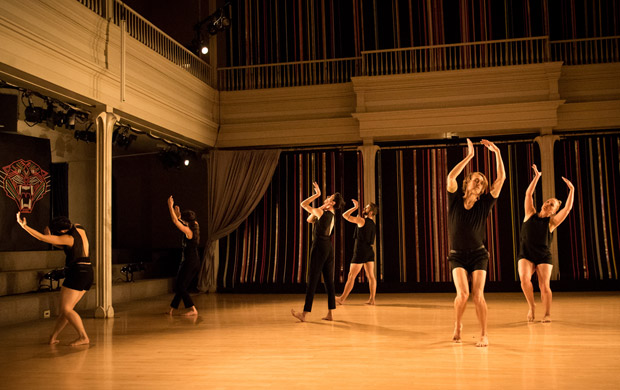
© Ian Douglas, courtesy Danspace Project. (Click image for larger version)
Chris Schlichting / Danspace Project
Stripe Tease
New York, Danspace
22 Oct 2015
Chris Schlichting on LinkedIn
www.danspaceproject.org
Danspace‘s latest offer, the New York premiere of Chris Schlichting’s Stripe Tease is a bit like an introverts’ cocktail party: it’s hard work.
Maybe that’s not quite right, but Schlichting’s piece, originally commissioned by Minneapolis’ Walker Art Center, lacks the variety and dynamics that make good conversations great, or good dance better.
Stripe Tease premiered in February of this year, and builds on a work Schlichting created in 2013, snippets of which are directly replicated in the opening of Stripe Tease. Although the first 20 minutes of the work are nearly silent, eventually Jeremy Ylvisaker and his band, Alpha Consumer, kicks in, playing a lush, varied soundscape that will appeal to fans of Andrew Bird–with whom Ylvisaker has a long-standing history. The sets, by Jennifer Davis, were stripey backdrops of velvety neutrals, rich primaries and metallics partnered with some vibrant animal portraits in the wings.
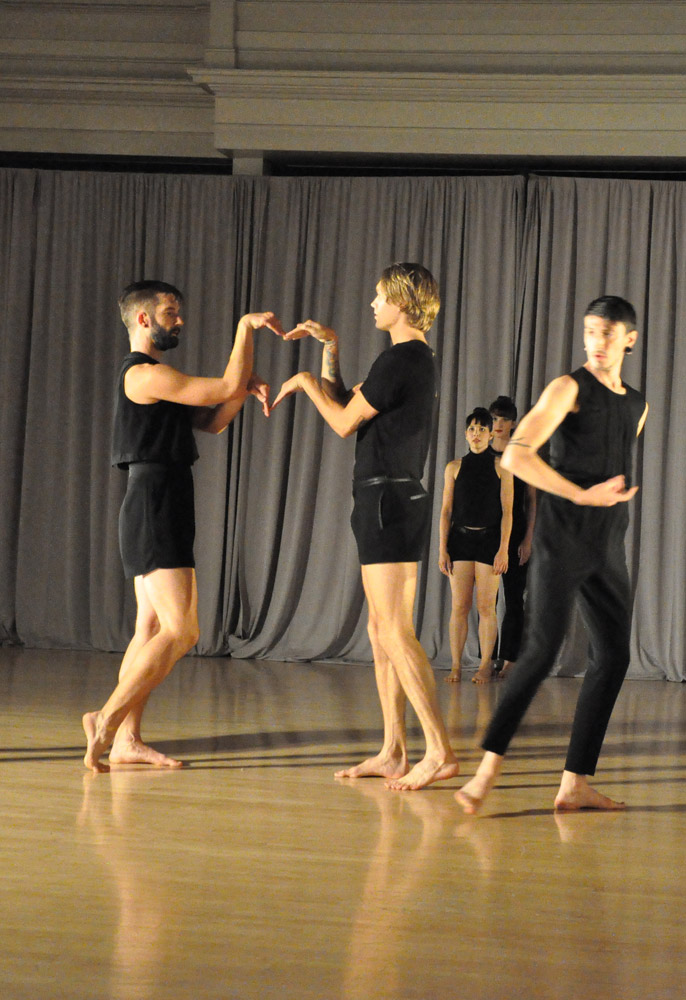
© Tom Brazil, courtesy Danspace Project. (Click image for larger version)
The Walker classifies Schlichting’s work as “movement art,” and there does seem to be some truth in this. The definition of dance is of course subjective, but one Stripe Tease audience member clarified it for themselves this way: “If I paid for something called a ‘dance class’ and walked out learning that, I would not be pleased. I can fidget alone in my room.” There are obvious references to ballet and modern dance vocabularies, but these remain references, instead of being woven into something of a larger scope of choreographic dialogue. They are just there, indifferent, sandwiched in and while Schlichting surely has his reasons, the conceptual intent doesn’t deliver, and onstage it falls flat. The primary structure to the work is created by utilizing repetition, which in an hour-long piece, can be tiresome to the senses if the movement vocabulary isn’t diversified enough. Repetition reliance requires taut aesthetic management.
The music changed more than the dancing did, though both elements thrived on hypnotic repetition. Stripe Tease opens with a vignette of slow motion voguing, two men framing their faces, shoulders and hips with effete, curving wrist motions. One man moves with predatory lewdness, the other with classical grace, as if he walked out of a frieze.
Midway through the piece, Ylvisaker’s score takes a turn, away from the twinklings and into a thrumming, visceral, reverb-heavy guitar akin to Jesus & Mary Chain. Here, Schlichting allows the dancers to let go, and they repeat many of the same motions, the same steps, but with more verve, more violence, more speed. The movement becomes larger, dancers get sweaty, and the space is spliced–not with a scalpel but with a hacksaw. The axis of all the dancers tilts a few degrees, everything about to careen off course.

© Tom Brazil, courtesy Danspace Project. (Click image for larger version)
This is one of the only times the music and movement appeared to have any relationship, and maybe that is asking for literalism, but Ylvisaker’s score is interesting, and offered mood swings a plenty. Schlichting’s choreography so rarely acknowledged changes in tempo, dynamic, or even chords, that it seemed arbitrary. A live three-piece band with a commissioned score requires a lot of work, and while the relationship between movement and music was not necessarily non-existent, it was certainly spotty.
One other brief, but satisfying section surfaced towards the end, and did seem to be led by the music. As the band fell listlessly into a lulling 60s-style ballad – all soft reverb with a hint of Hawaiian surf rock – dancers padded softly around the stage, tilting torsos as if in a dream, their arms curving with the care of the most refined temple dancers.












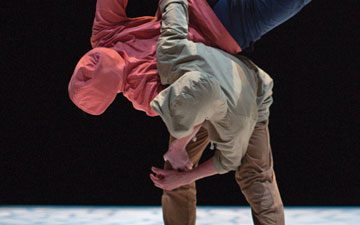
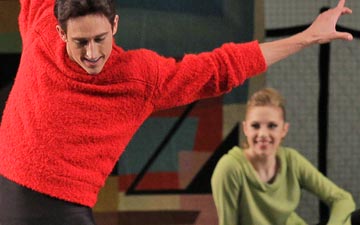

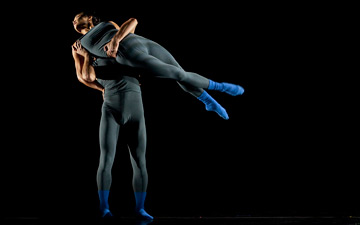
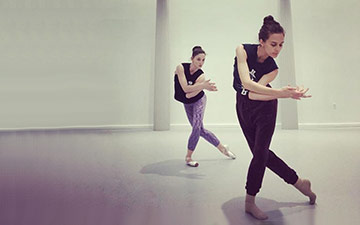
You must be logged in to post a comment.